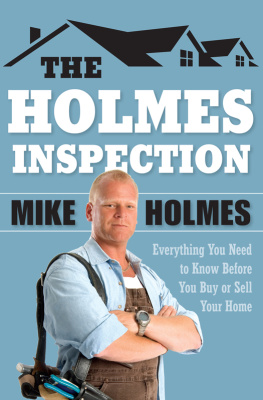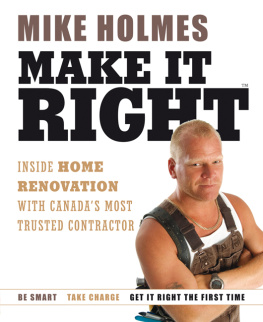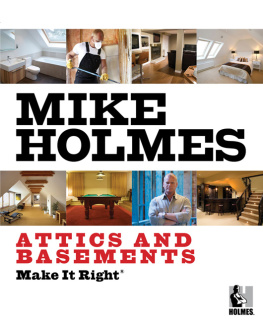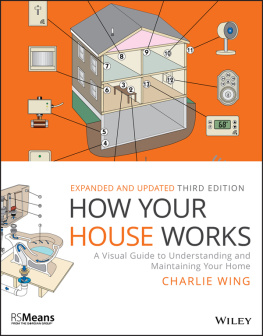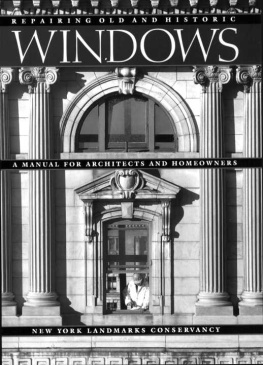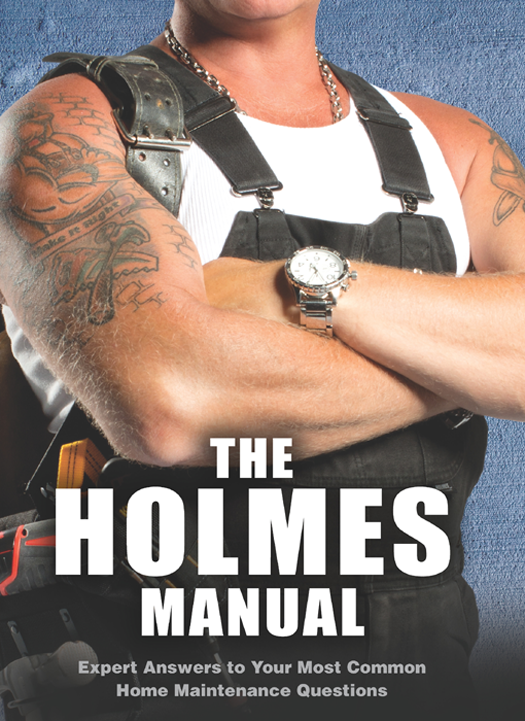Visit www.AuthorTracker.com for exclusive information on your favorite HarperCollins authors.
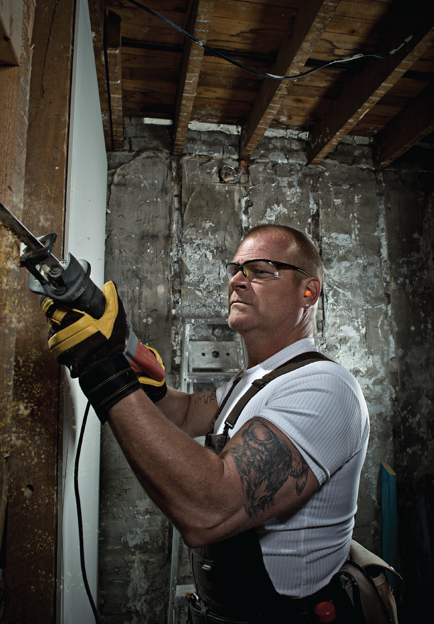
M ost of the renovations we do involve fixing something thats broken. Disaster is the starting point and our job is to make it right. Maybe the homeowners didnt see the signs. Maybe a bad inspector or contractor told them that there was nothing seriously wrong or that a Band-Aid solution would do the trick. By the time the homeowners called someone in, the problem was much harder to fix and more expensive. The Holmes Manual is all about how you can see the red flags sooner, take control, and save yourself a big headacheand a lot of time and money. Its about understanding how your house works and how to maintain it, and how you can protect your investment so your house outlasts you. If you dont take proper care of your house, it will deteriorate quickly. Theres a lot you can do to slow that down. Its all about making smart choices, and asking the right questions is a great first step.
In The Holmes Manual I answer common questions sent to me by homeowners, including:
How many roof vents should I have?
Should a brick house be waterproofed or sealed?
Why do some floorboards creak when I walk over them, and how can I fix them?
What do we need to consider when replacing old windows?
Are skylights a good idea?
What do we need to know about recessed lighting?
What is the life expectancy of plumbing?
What should I do to maintain my sump pump?
How should I look after my septic system?
What kind of grout should I use around my bathtub?
How much insulation should I have in my attic, and what kind is best?
How often should I have the ducts cleaned?
How can we prevent air leaks?
Can I paint my concrete basement floor or lay down carpet?
What kind of ceiling is best in a basement?
Should I buy green paints?
How can I tell if our house has mold?
Taking care of your house can seem difficult, but its not. Learning what you can doand more important, why you should do itis more than half the battle. Think of your house as a human body, with a structure that holds everything up, like your bones; an HVAC that keeps air flowing, like your lungs; and so on. Its a complex system, but there are simple steps to take so that everything runs smoothly. You look after your body, you get regular medical and dental checkups, and you eat right and exercise. Thats because youve learned that if you look after your health youll have a better quality of life and maybe even live longer.
Its the same with your home: when you maintain your house, its less likely youll have problems down the road. Knowing what to look out for can save you time and money and worry. I believe your house should outlast you, and it can if you take care of it.
Why not do what you can now to save yourself the hassle later? Use the best technologies and materials you can afford and look at repairs as opportunities to make things better before they have the chance to get really bad. Nothing lasts forever. Everything breaks down eventually. A house is no exception. But you do have the power to extend the life of your house. This book gives you the tools and knowledge to do that. Take care of your house, and it will take care of you.

I m starting with the outside of your home because, to me, this is very important. Too many times, I have witnessed people who buy a new home and right away start saving money for a new kitchen without paying any attention to the outside of the house. Why would you do a kitchen when theres a chance the exterior of your home will leak and ruin all that investment?
Start at the top. Most of us never look at our roofs. Out of sight, out of mind. We tend to walk around inside our homes and assume (or maybe hope) that everything is fine up on the roof. Im telling you now that you need to pay attention to your roof and your attic. Dont wait until problems happen. By the time you notice the roof is leaking, water will have broken into your home and done too much damage. Always work from your outside in, not your inside out.
The number one job of your exterior is to keep water out of the house. The better we can keep water out, the better off well be. Its not just the cost of insurance or the cost of cleaning up after a flood, its also the cost of our familys health. Moisture can lead to mold, which can make your indoor air hazardous; you breathe in those mold spores. Its true: indoor air is more polluted than the air outside because of the mistakes we make or maintenance we ignore around the house.
Next, people should get to know their attics. Go up into the attic in the spring and the winter to take a look. Make sure you dont see any signs of water coming in. You dont want to see frost buildup in your sheathing in the winter because it means your attic is not breathing. This could lead to mold and rot. Mold needs organic matter and moisture. Anything organic is like a steak buffet for mold; in the attic, that buffet is your wood framing. If youve got a poorly ventilated attic, youre going to get condensation in summer and frost (frozen condensation) in wintertheres your other food group: moisture.
Like so many parts of your home, your attic needs to breathe. What is the best breathing system you can have for your attic? A good ventilation system. This will give you excellent air movement: fresh air in through soffit vents, stale air out at the top through ridge vents or roof vents.
You also need to make sure the walls can breathe behind the exterior cladding. Thats why building codes for newer brick houses require an air space behind the brick veneer. Both stucco and brick veneers also require a drainage plane. The ability for air movement helps water to evaporate instead of penetrating your home.
Id like to see better products used on each and every home. Id like to see moisture-resistant, mold-resistant sheathing on the outside of our homes, such as one of the colored, coated lumber products. These products act as a barrier when it comes to moisture. Your second line of defense would be a high-quality building wrapinstalled properly, right down to the seamsto allow water to weep down and away from the house. This is the more important layer. It is both moisture-resistant and water-vapor-resistant, and it lets water weep as well as evaporate.
The point is your home is not all about looks. I dont really care what finish you have: its whatever is beneath your cladding that really matters. You have to have the right products in the right order to protect your home. Why? Because water will penetrate almost every single exterior clad. Making sure your home is wrapped properly will make sure that the water runs out, not in.


